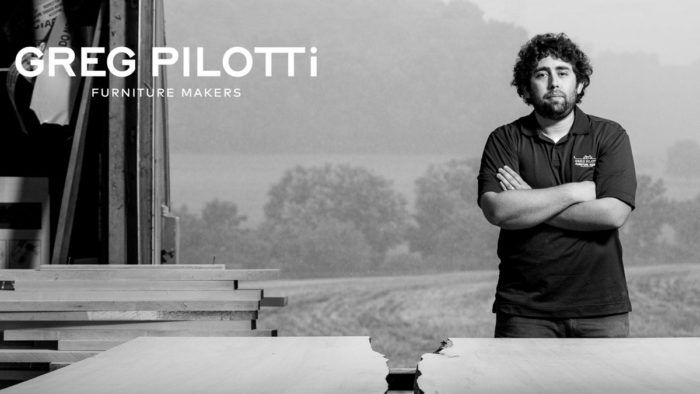
This is part of a series about different marketing tools for woodworkers. The others are linked below.
To be in business, you have to respond to demand; you can’t just do what you want. Part of the trick is to cultivate a demand for what you love to do. This is especially important for a business such as Greg Pilotti Furniture Makers that has employees; the pressure to meet payroll and overhead costs is unrelenting.
Pilotti started his business in 2013 as a part-time venture while training at Thaddeus Stevens College, then went full-time in 2015. Since then he has grown the business from a solo venture to one that also employs nine others. Pilotti specializes in commercial, not residential, work, so his marketing is a little different from that of many woodworkers, but the lessons he’s learned have broad relevance. Here are some key pieces of advice from Pilotti regarding online marketing.
Target your audience and tailor your posts accordingly
Pilotti uses Instagram primarily for networking with the kinds of people likely to want to work with him—architects and designers. “I don’t heavily target the how-to audience, because I mainly do commercial work,” he says. “I’m pretty happy in our world of commercial interiors. People just want you to hit deadline, and there’s a lot less emotion than with residential work.”
On Instagram, he focuses on finished pieces to indicate the type of work his business does. Still, he gives just enough behind-the-scenes perspective to remind followers that Greg Pilotti Furniture Makers really do make the things they sell—and that they’re people, not machines.
Pilotti recognizes that marketing is not just about pieces of furniture; it’s also about conveying to people who you are. “Instagram is great,” he says, “because it has evergreen content”—in other words, people can access all of your posts, going back to your very first one. If you’re thoughtful about what you post, he says, you can show where you came from, what you believe in, who your people are. “It’s a lot cheaper than a 45-minute phone call or spending a day meeting people and taking them out to lunch.”
Don’t ignore search engine optimization, and do be specific.
Search engine optimization (SEO) is critical to online marketing, says Pilotti, especially for a company like his that sells a niche product. “My product is an inch wide and a mile deep. You can’t just get in the car and start driving and find what we make. Getting Google to recognize a niche item is much easier than a broad topic; it’s not an item that has ten different names. Everybody knows what it’s called.”
Pilotti outsourced this back-end work. “When someone Googles our products, we come up in that search. What I don’t do is target raw terms such as “custom furniture maker.” There are thousands and thousands of them. I would have to spend too much to compete with them. We build a lot of stuff—we’re a custom shop, we’ll build anything—but my marketing is aimed at one product, because we know that product makes money, we know how to build it, and we know people are looking for it.”
Get in touch
Pilotti isn’t passive in his use of social media. He uses Instagram and Facebook to build relationships, then picks up the phone or writes an email to start a conversation. “I like their photos, then eventually introduce myself and say ‘I want to work with you,’ or ‘I want to be one of your suppliers.’”
Online tools can generate leads, but you still have to make the sale in house. Pilotti stresses the importance of having a plan for what to do when prospective clients get in touch. “What matters is to seal the deal. One of my biggest tactics is just being myself,” he says— “not ‘selling,’ but understanding what people are looking for. I don’t hit people over the head; I need to make deals work, and that means respecting peoples’ budgets.”
Keep in touch
Because Pilotti can stay busy working for a limited number of firms, he nurtures those relationships. He keeps in touch, because he’s genuinely interested in how they’re doing—for their sake and his. His clients have to be successful for him to stay in business.
Leverage your contacts through upselling
Pilotti credits The 1-Page Marketing Plan with enhancing his take on marketing. “McDonald’s has made millions on ‘would you like fries with that?’ upselling.” Pilotti’s version: “’Is there anything else you’re getting for your office/bedroom/kitchen? We do credenzas/bedside tables/rolling work tables.’ 50% of the time people ask us to bid on other items.”
Broadening the conversation in this way also helps keep advertising and marketing costs affordable. “If you try to advertise everything you do on your website, every product has to have its own ad campaign. If it costs you $25,000 a year to advertise your particular product, you have to think about multiplying your budget if you’re going to advertise other kinds of furniture as well. Then you have to sell more to have the money to pay for that advertising.”
Be judicious with what you reveal
“Instagram is a very powerful tool, but it doesn’t directly make me money. It’s a discovery tool and an authenticity tool. It’s also a slippery slope. I will tag a customer, but I will not share how I came to be working for that customer, because I would be throwing away all the work I’ve put into this” by giving away those contacts.
Also beware of how you come across. If you’re constantly complaining, “Hey, this is hard. We had a tough day, a tough break,” you may appear less capable than you are. We all have bad days; it’s fine to share that dimension of your reality. But as Pilotti puts it, “A client is looking for someone who’s on their game and able to solve their problem. My income is coming from my reputation for being knowledgeable, calm, innovative, production trained, and ‘we get it done,’ whereas in reality I’ve worn through the carpet in the hallway between my offices because of walking back and forth while freaking out. The reality is, we always get it done. We honor what we’ve agreed to do.”
Try different methods.
Don’t just assume that one kind of marketing doesn’t work. What doesn’t work for others may well work for you.
Be flexible
If you’re beating your head against the wall, switch to Plan B. If Plan B doesn’t work, switch to Plan C.
When Pilotti started his business, he was interested in doing traditional work—the kind of period, heirloom work he learned at Thaddeus Stevens College. The reality? Getting people to pay you for that kind of work is hard. His first website looked nothing like what it does today. “I learned the hard way that to make a living and employ people, I needed to make some branding changes. If you brand a company and try to stay in that mold, you’re not letting yourself breathe.”
-Nancy Hiller
Nancy Hiller is a professional cabinetmaker who has operated NR Hiller Design, Inc. since 1995. Her most recent books are English Arts & Crafts Furniture and Making Things Work, both available at Nancy’s website.
More on FineWoodworking.com:
- Marketing for Woodworkers: Print Ads by Nancy R. Hiller, Darrell Peart
- Marketing for Woodworkers: Shows, festivals, and exhibitions by Nancy R. Hiller with Michael Fortune
- Nancy Hiller’s Reality Check(list) – If you’re thinking of turning your passion into a profession you should take a deep look at what is involved in running a legitimate business.





















Log in or create an account to post a comment.
Sign up Log in